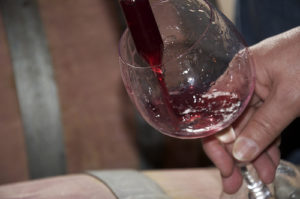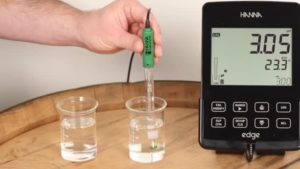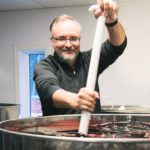
Are you having one of the many technical wine challenges often faced by winemakers? For fruit winemakers, working with fruit is not always an easy endeavor. I would dare say that making fruit wine is more difficult and the technical wine challenges can be greater in fruit wine than grape wine.
Despite the fact that all fruits will instinctively ferment to some degree under the right circumstances, there is a reason “fruit wine” really means “wine made from fruit other than grapes.” When asked why vitis vinifera won the world winemaking race, Dr. James Lapsley, wine historian and associate professor at the UC Davis Department of Viticulture and Enology explains, “Vinifera is unique in fruits in developing as much sugar as it does, thus resulting in a wine of 10-14% alcohol, which is more stable.
The Technical Wine Challenges
Ripe pineapple, for instance, is about 15% sugar. Therefore, most fruits need sugar additions, or water additions (to reduce acidity) or both. Vinifera makes itself, and hence became the standard.” Commercial fruit winemaking, by default, has largely become a quest for solidity and stability, dominant rather than self-inventing. One of the foremost battles any fruit winemaker wages is with the sugar content of the juice or must.
Depending upon the pH of the preliminary material, for a wine to have adequate alcohol to be microbially constant as well as have the right texture in the mouth, winemakers aim for at least 11.0% ethanol. On the basis of the sugar-alcohol alteration factor utilized (0.538 is a general starting point), that would entail an initial sugar content of 20.45 %. Many fruits can hardly top out at 12.0% (be careful of pulpy pendant solids in any hydrometer analysis—it is best to centrifuge samples). With numbers like those, it rapidly becomes apparent that adding sucrose, honey, concentrate, or some erstwhile form of fermentable sugar is essential. Crowe (2007)
What a producer is keen to add to a wine depends upon their stylistic goals. A Japanese study reviewed in the American Journal of Oenology and Viticulture (vol. 46 no. 1 1995) suggests that fruit wines sweetened by means of glucose and fructose, as is found in grape juice and fruit concentrates, scored higher in taste panels than the similar fruit wine sugared by un-cleaved sucrose. A few winemakers get pleasure from the bouquet and extra body that some kinds of honey adds to a product at the same time some only sweeten their wines via similar-fruit concentrates.
Others merely skirt the sugar-addition problem by adding together grape or other fruit brandy to their fruit wines to boost the alcohol content. What a producer can add to a wine is dependent on their federal and state laws and will impinge on how they eventually label the bottled product. For fruit winemakers in the U.S., TTB regulation group 27CFR4, listed at www.ttb.gov/regulations, is required reading, just reading this is in itself represents technical wine challenges. Ameliorate with slight of the “wrong” thing and all of a sudden an Upstate New York Pink Lady Apple Wine will have to be labeled as “Fruit Wine with Natural Flavors.”
 Attaining the acid equilibrium right is one of the the next technical wine challenges. The goal is to equal the level of acid to the completed wine style (sweet, dry, or fortified) while maintaining an adequate amount of acid for microbial solidity and color constancy, where pertinent.
Attaining the acid equilibrium right is one of the the next technical wine challenges. The goal is to equal the level of acid to the completed wine style (sweet, dry, or fortified) while maintaining an adequate amount of acid for microbial solidity and color constancy, where pertinent.
There is nothing erroneous with having a pH of 2.93 and a TA of 9.75 g/L in a raspberry dessert wine with 7% lingering sugar. The same final wine chemistry, in a dry apple wine, though, would be screamingly tart and the wine would be unhinged and unpleasant to drink. Crowe (2007)
The flip side is likewise hazardous. Low-acid musts (pH’s over 3.80 and TA’s below 5.0 g/L for example) can lead to bacterial incursion, stuck fermentations, high volatile acidity, a flat taste profile, greasy mouth feel, poor color, and a concise shelf life. Most winemakers conflict low acid musts by adding tartaric, citric, malic acid, or an amalgamation of all three.
High acid musts are occasionally de-acidified using calcium or potassium carbonate, but time and again, then are simply thinned with water and have sugar added back to the required fermentation level. In the United States, winemakers can add water up to 35%.
Fruit winemaking is often a juggling act of sugar, acid, flavor, dilution ratios, that in itself is one of the technical wine challenges facing winemakers. Being intimate in the knowledge of these factors, how they are interpreted by various laws governing wine production and sales in the market will ensure a higher degree of success.
Another important factor and challenge facing fruit winemakers is the identification of “wine problems” or flaws and faults that can occur in the wine process. Being able to identify this early ensures being able to remedy these problems.
Here is a list of “wine problems” and more importantly, how to identify them and hopefully resolve them. This is the first post of a three-part series. If interesting or useful, check out the other two parts.
Hopefully, your winemaking life will never encounter these problems, but that is unlikely. Just like in life, challenges and overcoming issues in wine make us better winemakers. Focusing on quality control in your winemaking and when issues do happen (and they will), learning from them will fine-tune your skills, overcoming technical wine challenges and help you produce sooner or later something fabulous.
If you need more good information on quality fruit wine production, contact me to purchase the ebook/PDF version of the Ultimate Fruit Winemaker’s Guide. Available for US$16.
Happy fruit winemaking!

Contact Dominic for any Wine, Cider or Mead consultation you need!
WinePlanet Consulting is a full service wine/cider/mead consultancy, ready and able to assist with your project anywhere.

I think this is right “wine made from fruit other than grapes.” Moreover, wine has also included many useful things. Through your information, every visitors simply consider how wine is making? Thanks for the informative information.
Thank you Shiza and you are welcome!